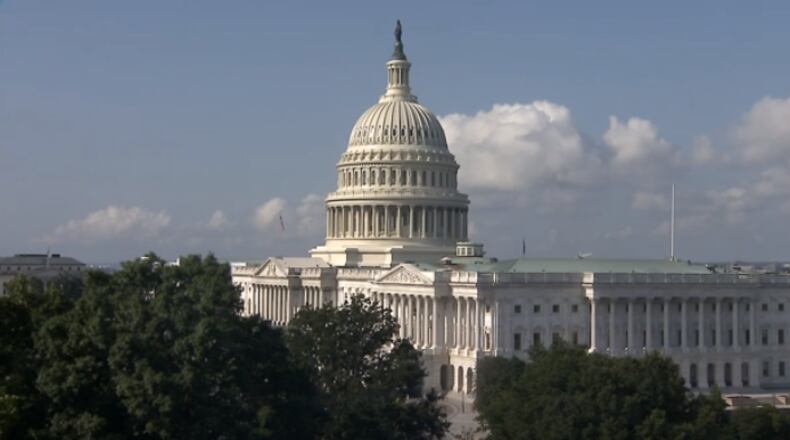Here are some things to look for in coming weeks:
1. Appropriations staffers will have a busy August on funding bills. There was no photo op, no remarks to reporters, no advance notice, as President Trump signed a two year agreement to set the spending caps for 2020 and 2021, as well as suspending the debt limit for two years. That doesn't end the budget work, as Congress will still have to fill in the details on a dozen bills to fund the operations of the federal government before a September 30 deadline. But it's not lawmakers who will be doing that grunt work - it means a lot of staff will be working while lawmakers are back home for a break that goes until the week after Labor Day. The last time Congress got all of that spending work done on time was in 1996.
President Trump signed 2-year budget spending caps-debt limit agreement into law per WH. Passed House 284-149 and Senate 67-28. pic.twitter.com/wVZvvF2IvB
— Craig Caplan (@CraigCaplan) August 2, 2019
2. No recess appointments for President Trump. After the President dropped his choice for Director of National Intelligence, a number of his supporters urged him to use the power to make recess appointments, in order to install his choice, without the involvement of the U.S. Senate. But that power is not available to Mr. Trump. While the House and Senate won't be taking any votes until the week of September 9, Congress is not adjourning, as the House and Senate will meet at least every three days (as required in the Constitution) - and that means there is no opportunity for President Trump to make any recess appointments. President Obama tried to do that, but lost 9-0 at the U.S. Supreme Court.
Recess appointment!
— Susan Metz (@Susan_Metz) August 3, 2019
3. The impeachment numbers grow in the U.S. House. Since the testimony of former Special Counsel Robert Mueller, several dozen Democrats in the U.S. House have announced their support for an impeachment inquiry against President Trump. The numbers are now up to a majority of Democrats in the House, and have been growing almost daily. House Speaker Nancy Pelosi remains publicly against the idea, but has left the door open for such a move. Watch in coming weeks during this August break to see if more and more Democrats come out in favor of impeachment proceedings.
Our nation has seen and heard things from this president that have no place in our democracy.
— Rep. Salud Carbajal (@RepCarbajal) August 2, 2019
I believe it is time to open an impeachment inquiry into President Donald Trump.
Read my full statement: https://t.co/itQlb5lqI1
4. Keep an eye out for more retirements. Even before five GOP lawmakers in the House - over an eight day period - announced they would not run for re-election, there had been ample rumors that a number of Republicans would end their Congressional careers. As I write this, 13 House members have decided not to run against for their seat in 2020 - 10 are Republicans, three are Democrats. When you see that kind of tilt, that usually tells us the party with the higher numbers does not feel optimistic about winning back the majority, or they don't feel good about the current political situation in general for their party.
In a surprise, Rep Will Hurd R-TX says he won't run for re-election, the third Texas Republican to hang up his cleats in a week https://t.co/cM9sxoV92N
— Jamie Dupree (@jamiedupree) August 2, 2019
5. Who is holding town hall meetings during the break? Back in August of 2009 and 2010, all of the political momentum was with Republicans and the Tea Party - as Republicans soaked up the grass roots anger back home, and many Democrats stayed away from town hall meetings where they would get an earful about the Obama health law. Now, it's the opposite. You don't see that many Republicans doing town halls - while Democrats are the ones talking about their meetings with constituents.
You spoke, we listened. Today’s Family Friendly Town Hall in #Orlando will take place on a weekend so working families like yours also have the opportunity to share your concerns with me. Hope you can join us. pic.twitter.com/EIkY6988qz
— Rep. Stephanie Murphy (@RepStephMurphy) August 3, 2019
Good morning morning to everyone, but especially the constituents of #VA10!
— Rep. Jennifer Wexton (@RepWexton) August 3, 2019
Don’t forget, my fourth town hall is TODAY—1pm at Manassas Park Middle School.
I want to answer your questions and hear directly from you.
See you soon! https://t.co/U1tYmgoGB8
6. Twitter may not be the best development for Congress. It shouldn't come as a surprise, but one of the disappointing uses for social media now in the Congress is that it allows lawmakers to personally attack each other - from long distance. In the old days, when lawmakers were on their August break, they were not interacting with each other. While Twitter and other platforms allow reporters to see what lawmakers are doing, it also lets Republicans and Democrats take swings at each other from hundreds of miles away. I'd have to say that doesn't bode well for the future. Here's one exchange this weekend which started when Rep. Liz Cheney (R-WY) was criticized by Rep. Alexandria Ocasio-Cortez (D-NY), who was then taken to task by Sen. Tom Cotton (R-AR).
MFW *Liz Cheney* of all people tries to offer foreign policy takes, as if an entire generation hasn’t lived through the Cheneys sending us into war since we were kids: https://t.co/xrOCN1c9OI pic.twitter.com/8Hoq1NbMC9
— Alexandria Ocasio-Cortez (@AOC) August 2, 2019
Many in our generation *volunteered* to fight. @TulsiGabbard did. @RepGallagher did. Where were you, @AOC? Playing politics.
— Tom Cotton (@TomCottonAR) August 3, 2019
And I’m surprised you’d suggest an independent woman like @Liz_Cheney shouldn’t speak her mind because of her dad’s views. Not very woke. https://t.co/72gHPGVlFA
It's safe to say, this is not my father's Congress.
About the Author

